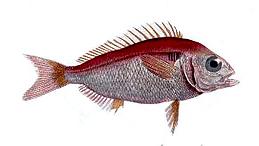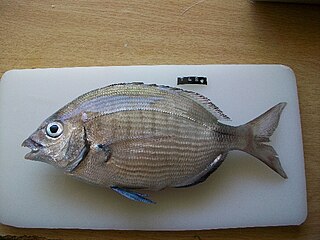
Sparidae is a family of ray-finned fishes belonging to the order Spariformes, the seabreams and porgies, although they were traditionally classified in the order Perciformes. They are found in shallow temperate and tropical waters around the world and are demersal carnivores.

Pagellus is a genus of marine ray-finned fish belonging the family Sparidae, which includes the seabreams and porgies. These fishes are found in the eastern Atlantic Ocean, the Mediterranean Sea and the western Indian Ocean.

Argyrops spinifer, the king soldierbream, Bowen snapper, long-spined red bream, longfin snapper, longspine seabream and red bokako, It is a species of marine ray-finned fish belonging to the family Sparidae. This species is found in the Indian Ocean.

Boops is a genus of marine ray-finned fishes belonging to the family Sparidae, the seabreams and porgies. There are two species in this genus, one in the Western Atlantic and Mediterranean, and the other in the Western Indian Ocean.

Diplodus is a genus of marine ray-finned fish belonging the family Sparidae, which includes the seabreams and porgies. These fishes are found in the Atlantic Ocean, the Mediterranean Sea and the western Indian Ocean.

Sparidentex is a genus of ray-finned fish belonging to the family Sparidae, which includes the seabreams and porgies. These fishes are found in the Indian Ocean.

Acanthopagrus is a genus of marine ray-finned fishes belonging to the family Sparidae, the sea breams and porgies. The fish in this genus are found in the Indian and western Pacific Oceans.

Rhabdosargus is a genus of ray-finned fish belonging to the family Sparidae, which includes the seabreams and porgies. These fishes are found in the southeastern Atlantic Ocean and throughout the Indo-West Pacific, although mainly in the western Indian Ocean.

Acanthopagrus berda, the goldsilk seabream, sly bream, picnic seabream, black sea bream, black porgy, picky bream, silver bream or river bream, is a species of ray-finned fish belonging to the family Sparidae, the sea breams and porgies. This species is found in the Indian Ocean.

Polysteganus is a genus of ray-finned fish belonging to the family Sparidae, which includes the seabreams and porgies. The fishes in this genus are found in the Indian Ocean.

Crenidens crenidens, the karanteen seabream or karanteen, is a species of ray-finned fish from the sea bream family Sparidae which was described by the Swedish zoologist Peter Forsskål in 1775. It is native to the western Indian Ocean but has colonised the eastern Mediterranean Sea since 1970. It is one of only three species in genus Crenidens, the others being the little known Crenidens macracanthus and the partially sympatric C. indicus.

Diplodus capensis, the Cape white seabream or blacktail seabream, is a species of marine ray-finned fish belonging to the family Sparidae, which includes the seabreams and porgies. This fish is found around the coasts of Southern Africa.

Spondyliosoma is a genus of marine ray-finned fish belonging to the family Sparidae, which includes the seabreams and porgies. The genus contains two species, one, the black seabream, from the eastern Atlantic Ocean and the other, the steentjie seabream, from the western Indian Ocean.

Argyrops is a genus of marine ray-finned fishes belonging to the family Sparidae, the seabreams and porgies. These fishes are found in the coasts of Indian Ocean and near Australia.

Crenidens indicus. Day's karanteen bream, is a species of marine ray-finned fish belonging to the family Sparidae, which includes the seabreams and porgies. This species is found in the Indian Ocean.
Crenidens macracanthus, Günther's karanteen, is a species of marine ray-finned fish belonging to the family Sparidae, which includes the seabreams and porgies. This fish is found in the Indian Ocean.

Chrysoblephus is a genus of marine ray-finned fishes belonging to the family Sparidae, the sea breams and porgies. The fish in this genus are found in the western Indian Ocean and southeastern Atlantic Ocean.

Gymnocrotaphus is a monospecific genus of marine ray-finned fish belonging to the family Sparidae, which includes the seabreams and porgies. The only species in the genus is the Gymnocrotophus curvidens, the Janbruin, an endemic to the coasts of South Africa.

Pachymetopon is a genus of marine ray-finned fishes belonging to the family Sparidae, which includes the seabreams and porgies. The species in this genus are endemic to Southern Africa.

Polyamblyodon is a genus of marin ray-finned fishes belonging to the family Sparidae, which includes the seabreams and porgies. The fishes in this genus are found in the Western Indian Ocean.


















